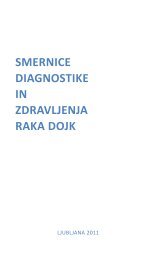You also want an ePaper? Increase the reach of your titles
YUMPU automatically turns print PDFs into web optimized ePapers that Google loves.
CpG oligonucleotides admixed with irradiated tumor<br />
cells are highly efficient for the tumor prevention but<br />
less effective for the treatment of existing tumors<br />
Vida Stegel 1 , Andreja Kopitar 2 , Alojz Ihan 2 , Srdjan Novakovi} 1<br />
1<br />
Institute of Oncology Ljubljana, Department of Molecular Diagnostics, Zalo{ka 2,<br />
1000 Ljubljana, Slovenia; 2 Medical Faculty, Institute of Microbiology and Immunology,<br />
Korytnikova 2, 1000 Ljubljana, Slovenia<br />
The CpG oligonukleotides could be used as immunostimulators that help the<br />
maturation of dendritic cells - DC and lymphocytes, and consequently help to trigger<br />
an antitumor immune response. The aim of our study was to assess the effectiveness<br />
of tumor vaccines composed of irradiated B-16 tumor cells and CpG when used<br />
for the prevention of tumor development or for treatment of i.p. B16 tumors. The<br />
prevention efficacy was assessed in the experiments that were performed on the<br />
intraperitonel (i.p.) B-16 mouse tumor model. The vaccines were administered<br />
once or three times i.p. The average survival (AM±SD) of control animals (mock<br />
treated) was 21.6±2.5 days. The average survival in the group of animals pretreated<br />
with irradiated tumor cells alone was 26.6±3.7 days. The 100-days-overall survival<br />
of animals pretreated once with irradiated B16 and 10 µg, 30 µg or 90 µg per<br />
animal of CpG was 57%, 30% and 28% respectively. In the very same groups, the<br />
average survival of the mice that ultimately died because of tumors was 43.3±33.0,<br />
30.0±15.2 and 42.0±10.7 days, respectively. When the animals were pretreated with<br />
the irradiated tumor cells and 10µg, 30µg or 90µg of CpG per animal followed by<br />
two repeated injections of CpG only, the 100-days-overall survival was 88%, 100%<br />
and 100% respectively.<br />
l22<br />
37<br />
In the second set of experiments, the effect of the vaccine on already established<br />
tumors was followed. The animals were first i.p. challenged with viable tumor cells,<br />
and on the second day, treated with CpG and irradiated tumor cells. The average<br />
survival in the group of animals treated with irradiated tumor cells alone was 20.0±9.8<br />
days. The average survival of animals treated with one injection of 30µg of CpG per<br />
animal was 21.0±7.2 days, while the average survival of animals treated with three<br />
repeated injections of 30µg of CpG was 24.0±6.7 days. Similarly to achievements<br />
in the previous groups, the treatment with one dose of irradiated tumor cells and<br />
one injection of 30µg of CpG per animal resulted with no long-term survivors.<br />
Average survival in this group was 21.0±6.4 days. Among the animals treated with<br />
the irradiated tumor cells and 30µg of CpG per animal followed by two repeated<br />
injections of CpG only, 18% of animals survived more then 100 days. The average<br />
survival of the mice that ultimately died because of tumors was 28.0±12.2 days.<br />
In conclusion, the tumor vaccine composed of irradiated B16 tumor cells and CpG<br />
delays the B16 tumor development and, to a great extent, protects the animals<br />
against tumor development. The curative treatment capacity of this kind of vaccine is<br />
limited with the size of the tumor mass. Therefore, the tumor vaccine is more useful<br />
for the prevention of tumor development than for the treatment of existing tumors.

















